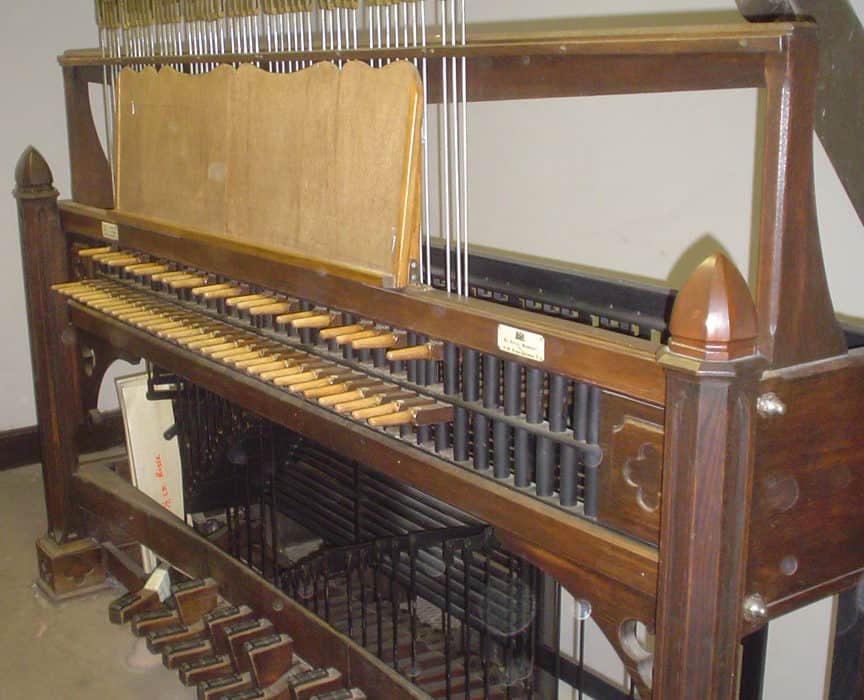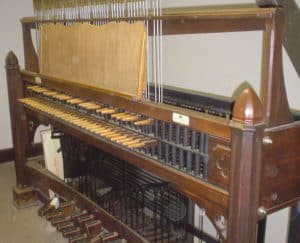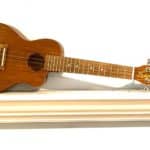
30
MayBells Will Be Ringing

Photo: Lee Leach
One of the many things I didn’t realize about Norwood before moving here is that we have the Walter F. Tilton Memorial Carillon at Town Hall. My undergraduate alma mater also has a carillon which I always enjoyed hearing, so I was excited the first time I heard bells here. I don’t remember the specifics but I suspect I was stopped at the light on Nahatan and Washington and figured the tower was at one of the churches on the Norwood Common since municipal carillons are not very common in the United States. Eventually I discovered it’s in Town Hall and try to listen for at least a few minutes whenever I hear the bells.
Our current Town Carillonneur, Lee Leach, is a frequent library user and at some point the topic of Norwood’s carillon came up in conversation. I told him how much I enjoy hearing the bells and that I am always reminded of my college days. The carillon world is fairly small; there are fewer than a dozen carillons in Massachusetts, so Leach knows the current carillonneur at my alma mater. Not only does she usually participate in the summer concert series, she also brings students to play at Norwood a few times a year. Earlier this winter I was lucky enough to go up in the tower and see/hear some Wellesley College students practicing.
I confess that although I liked hearing the bells on campus I never went up to see the carillon and knew nothing about how the instrument is played. Based on the variety of musical styles I heard, I knew they weren’t ringing the bells by pulling ropes, but beyond that I’m not sure I gave it much thought. For me, seeing the bells and learning how the instrument is played was more interesting than the view. I’ve since done quite a bit of research on the Walter F. Tilton Memorial Carillon, and carillons in general.
A carillon is defined as a musical instrument with at least 23 bells, and is usually in a tower or belfry – anything less than 23 is a chime. Norwood’s carillon has 50 bells as part of the instrument and a 51st bell, which is an old fire bell from Norwood. The carillon is played using a keyboard, or clavier, and pedal board. There are batons rather than keys and the player hits them with the side of his/her fist rather than the finger. Like an organ, there are many more pedals than on a piano. The bells are hung from a frame above the clavier and a series of wires with springs connect to the bell clappers. Striking a baton or pedal makes the wires move the clappers and sound is produced. The clavier can be open to the bell tower or in an enclosed space. Pipe organs are the instrument most similar to a carillon and organ pipes are the only instrument heavier than the largest carillon bells. The Walter F. Tilton Memorial Carillon’s largest, or Bourdon, bell is 71 inches in diameter and weighs 7,840 lbs., it sounds B-flat. Its smallest bell is 6.5 inches in diameter and weighs 11 lbs. Although there is music written for the carillon, many players rework other music for the carillon, including jazz and rock.
Tuned carillons became common during the 1600s in the Benelux countries in Europe, primarily in Belgium and the Netherlands. They were more often found in municipal buildings than in churches. In Singing Bronze: a History of Carillon Music, Luc Rombouts examines why Belgium and the Netherlands were centers of early carillon excellence. He argues that the weaving superiority of the region made it easier for them to create the wire components of the carillon. Reading that made me realize a weaving loom was exactly what the network of wires I’d seen running between the bells and keyboard reminded me of.
The skill of casting tuned bells came close to dying out, but by the turn of the twentieth-century the art had been revived. Before World War I there were fewer than half a dozen carillons in the United States. After the war, many Americans soldiers who heard them for the first time while fighting in Belgium and France felt that carillons were a fitting component of war memorials. Two English foundries: John Taylor and Co., and Gillett & Johnston cornered the American market.
The first municipal carillon in the United States was in Albany, New York’s City Hall. It was cast and installed in 1927 by John Taylor and Co. That company also cast the first carillon in Massachusetts at Our Lady of Good Voyage Church in Gloucester in 1922. The Walter F. Tilton Memorial Carillon is one of three carillons in Massachusetts made by the other significant English foundry, Gillett & Johnston. The Bancroft Memorial Carillon at St. Stephen’s Episcopal Church in Cohasset, dedicated in 1925, was Gillett and Johnston’s third carillon. Norwood’s carillon, dedicated November 11, 1928, was their eighteenth, and Wellesley College’s Galen L. Stone Tower in 1931 was their 34th. More than 30 carillons in less than 10 years made for a busy place – fourteen of those were installed in the United States. England’s Child: the Carillon and the Casting of Big Bells, by Jill Johnston is part biography of Cyril F. Johnston, part corporate history of Gillett & Johnston, and part memoir. Johnston was the child of Cyril F. Johnston and an American nurse who did not learn her father’s identity until after his death.
The Walter F. Tilton Memorial Carillon stopped being played in the late 1970s due to a need for repairs. Once work was begun, it was discovered the entire tower was seriously damaged by water leaks, and repairing the tower and fixing the leaks took precedence. By late 1982, work on the tower itself was nearing completion and the bells could be rehung. In early 1983, the expert hired to evaluate the needed work on the bells discovered that the second and eleventh bells were missing. With all the work that had been in done the tower there was no way to know when or how the bells disappeared. John Taylor, Ltd. of England was the foundry hired to repair and remount the bells. They cast replacements for the two missing bells.
Norwood’s first carillonneur was Kamiel LeFevere, a Belgian who came to the United States to play carillons. He was the first to play at St. Stephen’s in Cohasset and became the carillonneur at Riverside Church in New York City. LeFevere traveled to Norwood to play until 1934. His inaugural performance at the dedication of Norwood’s Town Hall and Carillon was broadcast on radio station WEEI. Roger Walker was the second carillonneur, playing from 1934 until 1972. He lived in Hyde Park, MA so had a much shorter commute for his performances. Martin Gilman played after Walker. George Mahoney, Jr. overlapped with Walker and Gilman. Sally Slade Warner was the carillonneur at St. Stephen’s in Cohasset and also played in Norwood. She managed the summer concert series for many years. Our current carillonneur, Lee Leach heard the Walter F. Tilton Memorial Carillon being played not long after he moved to Norwood in the 1990s. He decided to learn how to play the carillon and has been playing here since 1996. Before Leach, George Mahoney, Jr. was the only Norwood resident to play the Norwood carillon. Leach and Assistant Town Manager Bernie Cooper oversee the carillon. It is a volunteer position for Leach who coordinates the summer concert series, holiday performances and other special events, in addition to playing. There is now another Norwood resident and a few other regular players who are all volunteers.
The 2019 Summer Concert Series kicks off on Monday, June 24 at 7 pm and runs weekly until August 12. If Monday nights don’t work for you, Leach often plays during the farmers’ market on Tuesday afternoons. There will also be a concert on July 4th at 3 pm. The tower is generally open for visitors during or after performances for anyone who is curious to see the instrument. The library will be hosting “Meet the Carillonneurs” on Thursday, June 27 at 6:30 pm with Lee Leach and others who play the Walter F. Tilton Memorial Carillon.
If you have a third grader this year, s/he may go up in the carillon on their field trip to Town Hall. For youngsters who haven’t been up to the carillon, Rosie Meets the Carillon, by Kerri Lu is a story about a little girl whose grandmother plays.
Victoria Andrilenas is a Part-time Adult Services Librarian at the Morrill Memorial Library. Look for her article in the May 30, 2019 issue of the Norwood Transcript.








